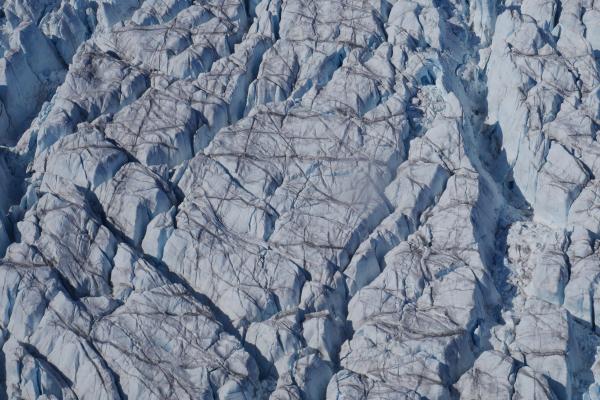Accelerating Ice Flow and Climate Change Spur Rapid Crevasse Expansion in Greenland

A new study published this week in Nature Geoscience reveals that in response to climate change, the Greenland Ice Sheet is developing significantly more surface crevasses in key regions —a change that may accelerate ice loss and contribute to rising sea levels.
The research, led by Byrd Center alum Thomas Chudley, a Research Assistant Professor at Durham University, analyzed high-resolution 3D surface maps and found that crevasses—wedge-shaped fractures in ice—had significantly increased in size and depth at the fast-flowing edges of the ice sheet over the entire Greenland Ice Sheet over the five years between 2016 and 2021.
Conducted by a team of researchers that included The Ohio State University's Byrd Center Director, Ian Howat, the ENGIE-Axium Professor and Distinguished University Scholar at the School of Earth Sciences as well as Byrd Center alum, Michalea King from the University of Washington, and Emma J. MacKie, an Assistant Professor at the University of Florida, the study employed high-resolution digital elevation models (DEMs) from the ArcticDEM project. With a resolution of approximately 2 meters, these DEMs allowed the researchers to capture fine-scale variations in the ice sheet's surface. By analyzing more than 8,000 individual maps covering nearly 89% of Greenland's melt zone, the team was able to extract pixel-based measurements of crevasse depth and integrate these data into detailed three-dimensional maps.
The research found that while the overall crevasse volume across the ice sheet changed by only about 4% over the study period, this average conceals dramatic regional differences. In marine-terminating sectors, where glaciers flow directly into the ocean, the crevasse volume increased by up to 25%, particularly in the southeast and central-east regions. These areas exhibited significant increases in crevassing. In contrast, the central-west sector, notably including Sermeq Kujalleq (Jakobshavn Isbræ), showed a decrease in crevasse volume of about 14%, correlating with a slowdown and thickening of the glacier in that area. However, recent data indicate that Sermeq Kujalleq is beginning to accelerate and thin again.
The analysis demonstrates that crevasse response to dynamic changes occurs much faster than previously recognized, highlighting the advantage of three-dimensional mapping over traditional 2D imagery. The observed increase in crevassing, especially at low-elevation, marine-terminating outlets, underscores how external forces such as warming oceans and atmosphere can trigger rapid feedback mechanisms in glacial dynamics. These crevasse-driven processes accelerate ice loss by channeling meltwater to the glacier bed and enhancing calving. The study also provides an essential foundation for improving dynamic models, ensuring that future predictions of ice-sheet behavior better account for the role of crevassing in a warming world.
This collaborative study has provided new insights into how glacier dynamics can respond on sub-decadal timescales, which is essential for forecasting the future impacts of climate change on the world's polar regions.
Read more about the study by visiting Nature Geoscience.
Related Links:
- Cracks in Greenland Ice Sheet grow more rapidly in response to climate change, EurekAlert
- New 3-D Study of the Greenland Ice Sheet Shows Glaciers Falling Apart Faster Than Expected, Inside Climate News
- Greenland ice sheet cracking more rapidly than ever, study shows, The Guardian
- The Greenland ice sheet is falling apart – new study, The Conversation
- Cracks in Greenland Ice Sheet growing more rapidly, Durham University
